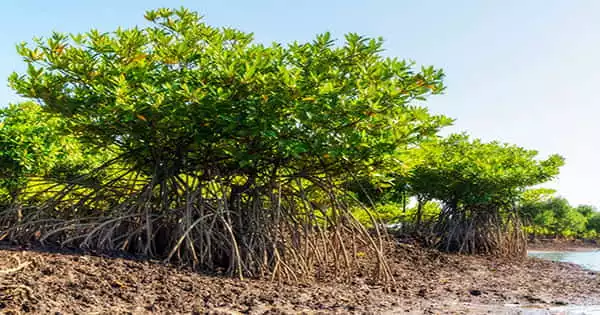Mangrove trees grow in tough conditions with quickly shifting salt levels and low oxygen levels, straddling the land-ocean divide. Most plants would die in these conditions, but mangroves have evolved a remarkable tolerance to the rigors of these harsh environments.
Mangroves are an ideal model system for studying the molecular mechanism behind stress tolerance, as they naturally cope with various stress factors.
Dr. Matin Miryeganeh
Researchers from the Okinawa Institute of Science and Technology Graduate University (OIST) have sequenced the genome of the mangrove tree Bruguiera gymnorhiza and discovered how it controls its genes to cope with stress. Their discoveries, which were recently published in the journal New Phytologist, might one day be utilized to assist other plants to become more stress-resistant.

“Mangroves are an ideal model system for studying the molecular mechanism behind stress tolerance, as they naturally cope with various stress factors,” said Dr. Matin Miryeganeh, first author of the study and a researcher in the Plant Epigenetics Unit at OIST.
Mangroves are an essential ecosystem for the globe because they protect coasts from erosion, filter pollutants from water, and provide a nursery for fish and other animals that sustain coastal lifestyles. They also help to counteract global warming by storing up to four times as much carbon as a rainforest in a given area.
Despite their importance, mangroves are being deforested at an unprecedented rate, and are expected to vanish in as short as 100 years owing to human pressure and rising oceans. Furthermore, genetic resources that may aid scientists in their efforts to maintain these ecosystems have been restricted thus far.
The mangrove project began in 2016, with a study of mangrove trees in Okinawa, as recommended by Sydney Brenner, one of OIST’s founding fathers. The investigators discovered that individuals of the mangrove tree, Bruguiera gymnorhiza, planted in the oceanside, with high salinity, and those rooted in the higher riverbank, where the waters were more brackish, displayed notable variations.
“The trees were amazingly different; near the ocean, the height of the trees was about one to two meters, whereas further up the river, the trees grew as high as seven meters,” said senior author, Professor Hidetoshi Saze, who leads the Plant Epigenetics Unit. “But the shorter trees were not unhealthy they flowered and fruited normally so we think this modification is adaptive, perhaps allowing the salt-stressed plant to invest more resources into coping with its harsh environment.”
Unlike long-term evolutionary adaptation, which entails changes to the genetic sequence, epigenetic alterations are used to adapt to the environment during an organism’s lifetime. Chemical changes to DNA alter the activation of distinct genes, affecting how the genome responds to various environmental stimuli and pressures. Plants, for example, rely substantially on epigenetic alterations to thrive because they can’t shift to a more pleasant habitat.
The researchers initially retrieved DNA from the mangrove tree Bruguiera gymnorhiza and sequenced its genome before concentrating on how the genome was controlled. They discovered that the genome has 309 million base pairs and a predicted 34,403 genes, making it far bigger than the genomes of other known mangrove tree species. The huge size was owing to the fact that repetitive sequences comprised up about half of the DNA.
When the researchers looked at the different types of repetitive DNA, they discovered that transposons, or ‘jumping genes,’ made up almost a quarter of the genome.
Prof. Saze explained: “Active transposons are parasitic genes that can ‘jump’ position within the genome, like cut-and paste or copy-and-paste computer functions. As more copies of themselves are inserted into the genome, repetitive DNA can build up.”
Transposons are an important driver of genome evolution because they introduce genetic variety, but they also have a negative side. Because disruptions to the genome caused by transposons are more likely to produce harm than benefit, especially when a plant is already stressed, mangrove trees have smaller genomes and repressed transposons than other plants.
This is not the case for Bruguiera gymnorhiza, according to the scientists, who believe that because this mangrove species is more ancestral than others, it may not have evolved an effective suppression mechanism.
The researchers next looked at how gene activity, including transposons, differed between people in the high-salinity oceanside site and those in the less-saline, brackish waters upriver. They also analyzed gene activity in mangrove trees produced in the lab under two distinct circumstances that mimicked the salt levels found on the oceanside and upriver.
Genes that restrict transposon activity had increased expression in both the oceanside people and those growing in high salinity conditions in the lab, whereas genes that typically enhance transposon activity had lower expression. Furthermore, when the researchers looked at transposons in particular, they discovered evidence of chemical changes to their DNA that reduced their function.
“This shows that an important means of coping with saline stress involves silencing transposons,” said Dr. Miryeganeh.
Increases in the activation of genes implicated in stress responses in plants, particularly those that activate when plants are deprived of water, were also seen by the researchers. Stressed plants also had decreased levels of photosynthesis, according to gene activity.
The team plans to investigate how seasons, temperature variations, and rainfall impact the activity of mangrove tree genomes in the future. “This study acts as a foundation, providing new insights into how mangrove trees regulate their genome in response to extreme stresses,” said Prof. Saze.
“More research is needed to understand how these changes in gene activity impact molecular processes within the plant cells and tissues and could one day help scientists create new plant strains that can better cope with stress.”





